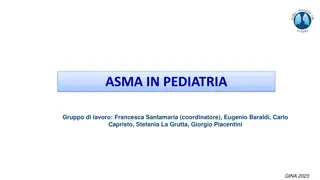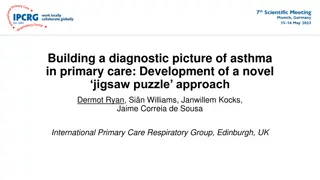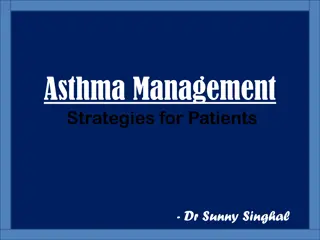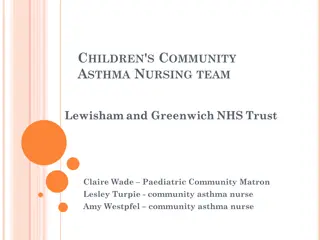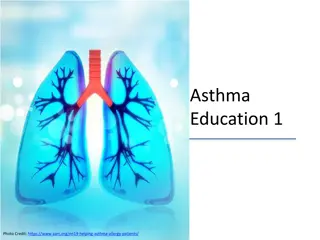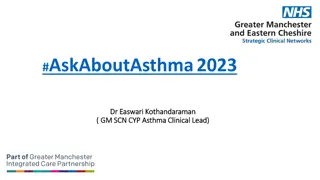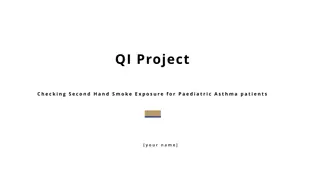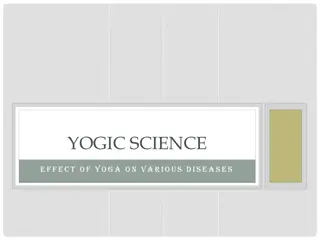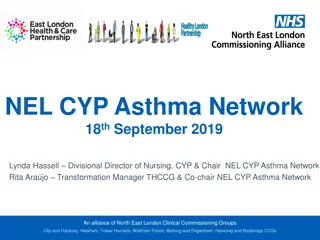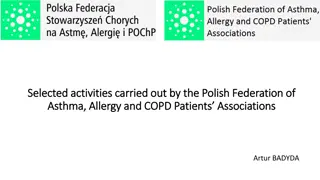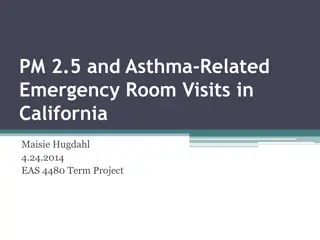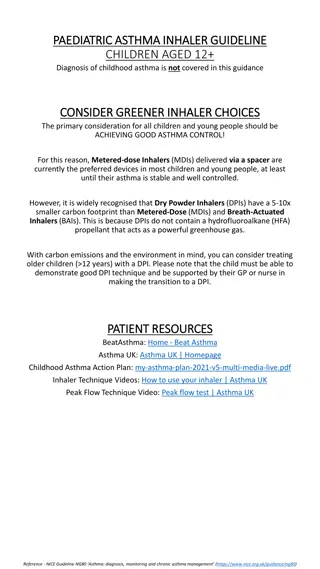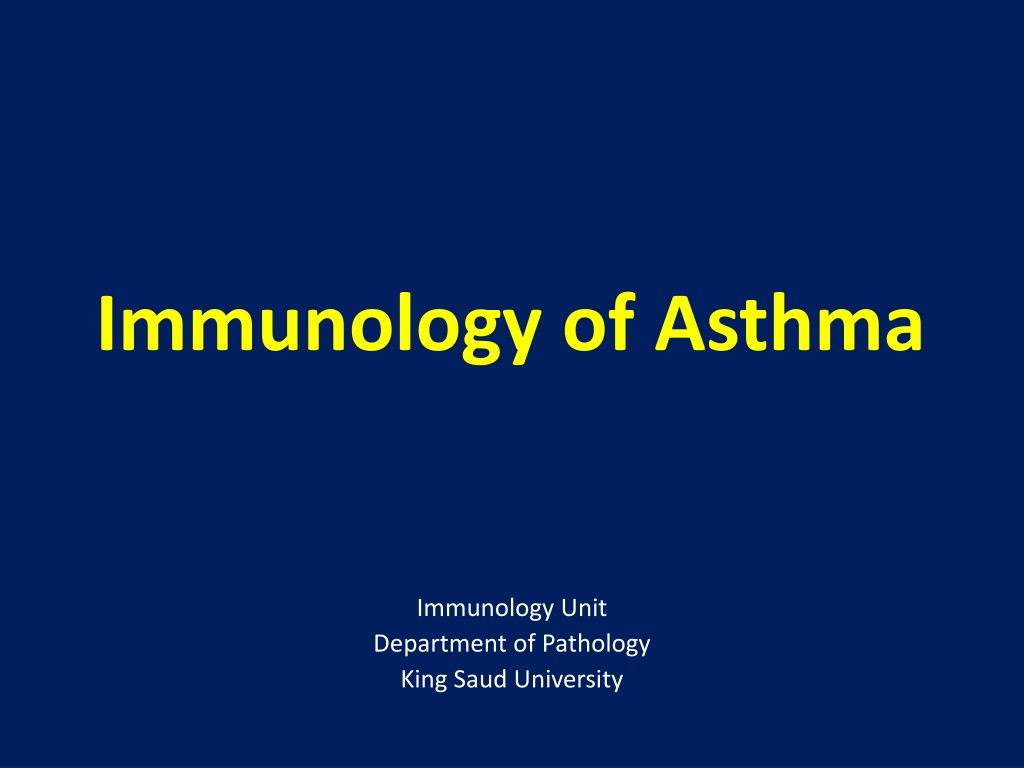
Understanding Asthma: Symptoms, Causes, and Classification
Explore the immunology of asthma, including the difference between extrinsic and intrinsic asthma, types of allergens, inflammatory processes, and airway remodeling. Learn about the clinical syndrome characterized by airway obstruction, bronchial reactivity, and inflammation, as well as common symptoms like breathlessness, wheezing, cough, and chest tightness. Discover the classification of asthma into intrinsic and extrinsic types and understand the role of allergens in triggering asthma attacks.
Download Presentation

Please find below an Image/Link to download the presentation.
The content on the website is provided AS IS for your information and personal use only. It may not be sold, licensed, or shared on other websites without obtaining consent from the author. If you encounter any issues during the download, it is possible that the publisher has removed the file from their server.
You are allowed to download the files provided on this website for personal or commercial use, subject to the condition that they are used lawfully. All files are the property of their respective owners.
The content on the website is provided AS IS for your information and personal use only. It may not be sold, licensed, or shared on other websites without obtaining consent from the author.
E N D
Presentation Transcript
Immunology of Asthma Immunology Unit Department of Pathology King Saud University
Immunology of Asthma Objectives: To the difference between extrinsic and intrinsic asthma To be familiar with types of allergens and their role in allergic sensitization To understand the inflammatory processes operating in allergic asthma To know about the airway remodeling
Asthma is a clinical syndrome characterized by: 1. Episodes of reversible airway obstruction 2. Increased bronchial reactivity 3. Airway inflammation
Patients with asthma present with one or more of the following symptoms: 1. Breathlessness (difficulty in breathing) 2. Wheezing 3. Persistent cough 4. Chest tightness
Classification of Asthma 1. Intrinsic (non-atopic) 2. Extrinsic (atopic) ( Atopy: genetic tendency to develop allergy)
Non-atopic (intrinsic) asthma (10-33% of asthmatics) More severe Older patients No clinical/family history of allergy Serum IgE levels are usually normal Negative skin tests
Atopic (extrinsic) asthma Allergies trigger asthma attacks in: 60-90% Children 50% Adults Approximately 75-85% of patients with asthma have positive (immediate) skin test reactions to various allergens
Role of Allergens in Asthma Allergen sensitization is linked to the risk of developing asthma Indoor allergens House dust mites Domestic pets (cat fur & dander) Cockroaches (insects) Molds (fungal spores)
Outdoor allergens: -Fungal spores (e.g. Alternaria) - Grass, tree & weed pollens Fungal spores Grass pollens Tree pollens
Antigen presenting cells (APCs) in the lung: Two subsets of dendritic cells (DCs) in the lungs: One subset of DCs called respiratory tract myeloid DCs (mDCs) help in the development of asthma symptoms Second subset known as plasmacytoid DCs (pDCs) aid in respiratory tolerance to allergens
In susceptible individuals Inhaled allergen First encounter with allergens activate B-cells to produce IgE Subsequently: Inhaled allergens activate submucosal mast cells in the lower airways Mediators are released within seconds causing: 1. Bronchoconstriction 2. Influx of eosinophils & other inflammatory cells
Asthma results from complex interactions among the inflammatory cells that involve: 1. Airway epithelium 2. Nervous system 3. Bronchial smooth muscles
Factor contributing to airflow obstruction leading to difficulty in breathing include:
Early allergic response 1. Occurs within minutes 2. Manifests clinically as: - Bronchial constriction - Airway edema - Mucus plugging Is reversible and responds to bronchodilators
Late allergic response: 1. 2. Appears 4 to 10 hours later Results from infiltration by inflammatory cells. Activation of lymphocytes & eosinophils 3. Responds to steroids (Anti-inflammatory drugs)
Th2 cells and role of cytokines in allergic asthma
Allergens drive T-cells towards Th 2 type: Th2 secrete the cytokines: IL-4, IL-5, IL-9 & IL-13 which promote : 1. 2. 3. 4. Production of IgE by B cells Eosinophil attraction and infiltration Airway inflammation Increased bronchial reactivity
Role of IL-4 in allergic asthma The main role of IL-4 is carried out during the initial priming of Th2 cells : 1. Regulates isotype switching in B cells to IgE Induces MHC II on antigen-presenting cells Induces adhesion molecule expression Activate mast cells and eosinophils 2. 3. 4.
Role of IL-13 in allergic asthma 1. IL-13 induces inflammation 2. Stimulates mucus hyper- secretion 3. Induces sub-epithelial fibrosis
Role of IL-5 in allergic asthma 1. IL-5 induces an increase in eosinophil production in the bone marrow 2. Release of eosinophils from the bone marrow into circulation
Role of eosinophils in allergic asthma Eosinophils initiate asthmatic symptoms by causing tissue damage in the airways of the lungs Production of eosinophils is inhibited by IL-10
Role of regulatory T cells: Regulatory T cells suppress the effector mechanisms that induce asthmatic symptoms Asthmatics may lack functional regulatory T cells that can inhibit an asthmatic response
Activation of inflammatory cells (mast cells, eosinophils etc,) is a major inducer of airway inflammation. Airway inflammation is the hallmark in the asthmatic lung which leads to : Increased bronchial reactivity
Products of the inflammatory cells act on : 1. Airway smooth muscle cells 2. Lung fibroblasts 3. Mucous glands and cause : Airway Remodeling
Airway remodeling refer to: 1. Smooth muscle hyperplasia & hypertrophy 2. Mucous gland hyperplasia 4. fibroblast activation 3. Collagen deposition 5. Chronic inflammation 4. Fibroblast activation
Inflammatory cells & their mediators Airway inflammation Increased bronchial Airway remodelling reactivity
Outcome of increased airway reactivity Predisposes patients to develop asthma attacks on exposure to non-specific irritants: 1. Chemical irritants 2. Smoke & strong perfumes 3. Sulphur dioxide & air pollutants 4. Viral and bacterial respiratory infections
Outcome of airway remodeling Can ultimately lead to fibrosis and irreversible airway obstruction in some patients
Take home message 1. Asthma is characterized by episodic reversible airway obstruction 2. Classified in 2 types: intrinsic & extrinsic 3. In the extrinsic type allergens drive T-cells into Th2 pattern 4. Airway inflammation is a hallmark finding in the asthmatic lung 5. Inflammatory cells lead to increased bronchial reactions & airway remodeling which is not revisable


